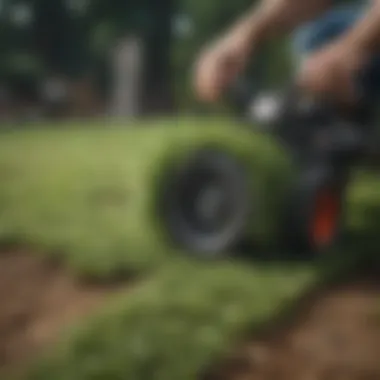Best Weed and Feed for Healthy Sod Care


Intro
Maintaining a robust and healthy lawn is essential for any homeowner looking to enhance their property’s aesthetic appeal. Among the various methods to achieve a vibrant lawn, using weed and feed products stands out as an effective strategy to manage both plant nutrition and weed control simultaneously. In this guide, we will explore the top options available, important application techniques, and best practices for sustaining healthy sod. Understanding the specific needs of sod is crucial, as it often requires a tailored approach to both fertilization and weed management.
Key Insights and Trends
As landscaping evolves, so too do the products and techniques used for maintaining lawns. Here are some key insights into current trends in sod care and weed management:
Current Trends in Lawn Care
- Organic Solutions: More homeowners are turning to organic weed and feed options. These products often utilize natural ingredients that not only nourish the grass but also limit environmental impact.
- Slow-Release Fertilizers: There is a growing preference for slow-release fertilizers. They provide steady nutrients over an extended period, reducing the frequency of application.
Popular Gardening Techniques
- Integrated Pest Management (IPM): This approach combines various practices for effective weed and pest control. Homeowners are encouraged to understand their lawn ecosystem for optimized management.
- Mulching: Many gardening enthusiasts are adopting mulching practices to suppress weeds naturally. This creates a barrier while enriching the soil as the mulch decomposes.
Practical Tips and How-To Guides
Choosing the Right Product
Choosing the best weed and feed product is crucial for sod health. Here are a few factors to consider:
- Soil Type: Different soil types require specific nutrients. Conduct a soil test to understand its composition.
- Grass Variety: Various grass types thrive under different conditions. Select a product optimized for your specific sod variety.
Application Techniques
- Timing: Apply weed and feed during active growth periods. This maximizes absorption and effectiveness.
- Even Distribution: Use a spreader for uniform application. Uneven distribution can lead to patchy growth and unsatisfactory results.
"Applying weed and feed at the right time is crucial. Early spring and fall are often the most effective periods to engage with these products."
Maintenance Practices
After applying weed and feed, ongoing care is essential:
- Watering: Water your lawn lightly after application. This helps wash the product into the soil.
- Mowing: Maintain your grass at a proper height. Longer blades are better at competing with weeds.
By focusing on these aspects, you can cultivate a lawn that is not only aesthetically pleasing but also healthy and resistant to weeds. Understanding the market trends, choosing the right products, and applying them correctly are all critical steps for homeowners aiming to optimize their sod’s performance.
Preamble to Weed and Feed
Weed and feed products serve a crucial role in maintaining the health of sod. Their function is not merely about keeping the lawn looking neat; it's about ensuring the grass receives necessary nutrients while simultaneously controlling weed growth. Understanding how these products work and their application can lead to a healthier, more vibrant lawn.
Definition and Purpose
Weed and feed refers to a combination of herbicides and fertilizers in a single application. The primary purpose is to fertilize the lawn while simultaneously tackling unwanted weeds. The product is designed to address both aspects in a manageable manner. Lawn enthusiasts often find that managing weeds can be a time-consuming task. By choosing weed and feed products, they can streamline their approach, saving time and effort that would otherwise go into separate applications.
There are two main components in weed and feed formulations:
- Fertilizers: These provide essential nutrients to sod, supporting its growth, color, and resilience. Typically, these fertilizers contain nitrogen, phosphorus, and potassium, which foster healthy grass development.
- Herbicides: These specifically target common weeds such as dandelions and clover, reducing competition for nutrients and water.
By using a single product, homeowners can simplify their lawn care routine, but it is critical to understand both components to get the best results.
Benefits of Using Combined Products
The advantages of using weed and feed products extend beyond convenience. Key benefits include:
- Time Efficiency: Applying both fertilizer and weed control in one step saves time, especially for those with larger lawns.
- Cost-Effectiveness: Purchasing a combined product can often be cheaper than buying separate items. This can be particularly beneficial for homeowners managing budgets.
- Improved Lawn Health: A well-nourished lawn is better equipped to fend off weeds. The simultaneous dosing of nutrients and weed inhibitors promotes a robust growth environment.
"Using weed and feed products can dramatically improve the health and appearance of your lawn if applied correctly."
Despite these benefits, it is essential for users to be careful. Understanding your lawn's specific needs and the characteristics of the weeds present is vital for achieving optimal results. Choosing a weed and feed product that matches your sod type and the season will further enhance effectiveness.
Understanding Sod Basics
Understanding sod is critical for maintaining a healthy lawn. Different types of sod come with varying characteristics, behaviors, and maintenance requirements.
Through recognizing sod types and their growth needs, one can tailor weed and feed practices more effectively, leading to healthier greens. Understanding sod provides groundwork for applying suitable weed and feed products.
Different Types of Sod
Cool-season grasses
Cool-season grasses thrive in the northern climates. They grow best during the cooler parts of the year, particularly in spring and fall. Their key characteristic is their ability to withstand lower temperatures. This makes them a preferred choice for many gardeners in cooler regions. They can provide a lush, green lawn when properly maintained.


One unique feature is their growth pattern, which slows during high summer heat. This leads to a dormant period, often resulting in brown patches if not managed correctly. The main advantage is their resilience to cold and adaptability, allowing them to recover quickly in spring. However, they may require more water during active growth periods compared to warm-season grasses.
Warm-season grasses
Warm-season grasses flourish in warmer climates. They do best in summer when temperatures are higher. One notable aspect is their fast growth rate during hot months, creating a vibrant and thick lawn. These grasses are particularly advantageous in southern regions where summers are long.
A unique feature of warm-season grasses is their drought resistance. They have deeper root systems, which can access moisture more effectively. However, this type of sod can struggle during cold weather. They tend to go dormant and can turn brown with frost, requiring careful seasonal planning.
Sod Growth Requirements
Sunlight
Sunlight is a crucial growth requirement for sod. Most grass types need at least six hours of direct sunlight daily. Adequate sunlight allows for photosynthesis, which is necessary for robust growth. Proper light exposure significantly contributes to the health and appearance of your lawn.
A unique feature is that each sod type has different sunlight needs. For instance, while cool-season grasses favor partial shade, warm-season types require full sun. Maintain the right balance of sunlight to avoid growth issues.
Soil type
The correct soil type supports optimal growth for sod. Soil should be well-draining and rich in nutrients. Many sod varieties prefer loamy or sandy soils that promote healthy root development.
A noteworthy detail is that compacted soil can hinder growth, preventing roots from spreading adequately. Testing soil composition can identify nutrient deficiencies, ensuring the right amendments are added for successful sod growth.
Watering needs
Watering is essential for sod health. Newly laid sod needs more frequent watering to establish roots. Appropriate moisture levels help in sustaining growth, especially in the first few weeks.
One unique aspect of watering is the distinction between established and newly laid sod. Established sod requires less frequent watering, about once a week, while newly placed sod may need daily moisture.
Achieving the right balance in watering can help prevent weeds from establishing themselves in the sod.
Understanding sod basics is a vital step in maintaining a vibrant and healthy lawn. By recognizing the types of sod and their specific requirements, homeowners can make informed decisions in their lawn care practices.
Weeds Commonly Found in Lawns
Understanding the weeds that commonly invade lawns is essential for effective weed and feed strategies. Weeds not only compete with sod for nutrients, but they also diminish the overall aesthetic quality of the grass. Identifying these invasive plants is the first step toward maintaining a healthy lawn. A thorough examination of common weeds helps homeowners plan appropriate control measures, ensuring their sod remains vibrant and well-nourished.
Identification of Common Weeds
Dandelions
Dandelions are easily recognizable due to their bright yellow flowers that bloom in spring. They thrive in diverse environments, making them a common sight in many lawns. The taproot of the dandelion allows it to access water and nutrients from deeper soil layers, making it resilient against small droughts. However, this feature also means they can be difficult to remove entirely, often requiring persistent effort.
One notable aspect of dandelions is their ability to attract pollinators, which can be an argument for their presence in gardens. However, their rapid seed dispersion contributes to their classification as a weed, making them a concern for sod health. Homeowners should keep an eye on these bright plants, as their presence can signal a decline in lawn vitality.
Clover
Clover is another common lawn weed characterized by its distinct three-leaf structure. It has advantages that can benefit lawns; it naturally fixes nitrogen in the soil, which can enhance the nutrient profile for neighboring sod. This makes clover partially beneficial, especially in areas where soil quality is compromised.
However, clover can also dominate patches of grass if left unchecked. It tends to spread quickly and can outcompete desired grasses for nutrients and water. Balancing clover's benefits and its potential for overgrowth is crucial for maintaining a healthy lawn. Homeowners may want to consider this dual nature when managing their lawns.
Crabgrass
Crabgrass is an annual grassy weed that typically appears in late spring and early summer. It has a sprawling growth pattern which allows it to quickly cover ground. Crabgrass thrives in disturbed soils, making it a frequent invader of poorly maintained lawns. Its growth habit is concerning because it can smother the underlying sod, leading to bald patches if not addressed.
One of the key characteristics of crabgrass is its high heat tolerance. It can survive when the main grasses are struggling, potentially worsening the conditions of the lawn. Its ability to produce a large amount of seeds ensures that it can establish itself year after year. This resilience makes crabgrass a challenging weed for homeowners aiming to keep their lawns healthy.
Impact of Weeds on Sod Health
The presence of weeds negatively impacts sod health by competing for essential resources. Nutrients and water are shared between the weed and the grass, leading to inevitable deficiencies in the desired lawn. Furthermore, invasive weeds like dandelions, clover, and crabgrass can harbor pests and diseases that may spread to the sod. This aspect underscores the importance of regular monitoring and treatment of weeds within the lawn.
To maintain lawn integrity, effective weed control measures should be used. These can range from manual removal to applying targeted herbicides that align with specific seasonal timings for maximum effectiveness.
In summary, weeds are a significant factor affecting sod health. A proactive approach to their identification and management can lead to a more resilient lawn, ensuring that the grass can flourish without the burden of invasive plants.
Factors to Consider When Choosing Weed and Feed
Choosing the right weed and feed product is essential for achieving a healthy lawn. Different products cater to various needs, so understanding your specific situation can enhance the effectiveness of your efforts. Factors like the type of weeds present, the species of sod you have, and the timing of application should all shape your decision-making process. This section examines these important elements closely.
Type of Weeds
Understanding the types of weeds in your lawn is critical. Different weeds require different solutions. For instance, perennial weeds, like dandelions, may need a stronger treatment compared to annual weeds such as crabgrass. A targeted approach enhances the effectiveness of your weed and feed product.
- Perennial Weeds: These weeds can survive multiple seasons. Products designed for these are often selective and will target specific species, helping to prevent them from returning.
- Annual Weeds: These weeds live for only one season. Products aimed at these types may include pre-emergent mechanisms to stop their growth before they sprout.


Identifying your weed types not only helps in choosing the right product but can also inform you on the optimal application time and method.
Type of Sod
The specific type of sod in your lawn significantly influences your choice of weed and feed. Different grasses have unique growth requirements and tolerances. For example, cool-season grasses, like Kentucky bluegrass, thrive in spring and fall, while warm-season grasses, such as Bermuda grass, do better in the summer.
- Cool-Season Grasses: Suitable products for these grasses often have higher nitrogen content for robust growth during their active months.
- Warm-Season Grasses: Products with a balance of nitrogen and potassium might work better, as these grasses require different nutrients to thrive in their warm growth phase.
Recognizing your sod type not only helps in selecting the best product but also aids in optimizing nutrient uptake and lawn health.
Seasonal Timing
Timing is a crucial factor when applying weed and feed treatments. Each product is designed with specific seasonal application in mind, and understanding these timings can improve results.
- Spring Application: This is often the ideal time for cool-season grasses. Applying weed and feed too early can damage the sod or be ineffective against emerging weeds.
- Summer Application: For warm-season grasses, late spring to early summer is usually the recommended window. Proper timing ensures that the product works when both the weeds and the grass are actively growing.
Application out of season can result in wasted product and missed opportunities for effective weed control. Always check product labels for specific guidance on when to apply.
Tip: Regular monitoring of your lawn can help to identify the best times for application, ensuring long-term success.
By carefully considering the type of weeds, sod, and optimal application timing, you can make informed decisions when selecting weed and feed products that will promote a vibrant, healthy lawn.
Top Weed and Feed Products Reviewed
The selection of weed and feed products can significantly impact the health and appearance of sod. Understanding the unique characteristics of each product helps homeowners make an informed choice. Here, we will explore three products that stand out in the market. They vary in composition, target weeds, and application process. Each element is crucial for achieving a balanced lawn with minimal weed interference.
Product A - Detailed Analysis
Composition
Product A incorporates a nitrogen-rich blend alongside potent herbicides, which promotes both growth and weed control. The key characteristic of this product is its slow-release formula, benefiting the lawn over an extended period. It is a popular choice due to its effectiveness in delivering nutrients consistently. The unique feature here is the inclusion of organic ingredients, which can make it safer for pets and children while still being effective. However, this can lead to slower action against weeds compared to purely synthetic options.
Target weeds
This product targets a wide range of weeds such as dandelions and crabgrass. The specific aspect of targeting makes it effective for homeowners dealing with diverse weed species. The broad spectrum of weeds it addresses is a major advantage. Nonetheless, those looking for a solution for particularly persistent weeds may find it less effective due to its generalization.
Application process
The recommended application process for Product A involves using a spreader for even distribution. This method is effective in ensuring uniform coverage, which is vital for optimal results. It is beneficial because it minimizes the risk of oversaturation or bare patches. Nonetheless, some users may find the spreader setup cumbersome, leading to uneven application if not done carefully.
Product B - Detailed Analysis
Composition
Product B has a significant concentration of potassium and phosphorus, promoting root development in addition to weed control. This composition is especially beneficial for lawns that need nutrient replenishment. Its distinctive characteristic is its quick-dissolve granules. This means lawn care results can be expected in a short time frame. However, this fast-acting nature may lead to a higher chance of nutrient leaching during heavy rainfall.
Target weeds
Specifically designed to target perennial weeds, Product B excels against stubborn varieties. This is its main strength, making it a preferred choice among gardeners dealing with specific issues. However, its fixation on a narrower range may limit its effectiveness against annual weeds, leading to a potential resurgence of diverse weed types.
Application process
Applying Product B is straightforward, with instructions recommending a light watering after application to activate the nutrients. This process is user-friendly and increases the rate of absorption into the soil. The simplicity of this application method is advantageous, but excessive watering can dilute the effects, reducing efficiency.
Product - Detailed Analysis
Composition
Product C features a well-balanced formula designed specifically for sod health. The composition includes a proprietary blend of synthetic and organic materials. Its key feature lies in its enhanced micronutrient profile, ensuring that the lawn receives not just primary nutrients but also essential trace minerals. This holistic approach makes it a beneficial choice for long-term lawn care. However, the proprietary aspects may lead to questions about its ingredients' safety and effectiveness compared to more transparent formulations.
Target weeds
This product is effective against common lawn weeds like clover and various broadleaf species. It stands out for its targeted action, minimizing harm to the grass itself. One limitation, however, is its potential ineffectiveness against tougher weeds like dandelions, which may require additional treatments.
Application process
For Application of Product C, it is suggested to use it during moist conditions to enhance adherence to the foliage and soil. This key tactic has shown to improve efficacy significantly. Its unique characteristic of being best applied before rain can be seen as an advantage, but it can create challenges during dry spells when ideal application conditions are harder to find.
Application Techniques
The application techniques for weed and feed products play a critical role in achieving a healthy sod. Effective application can significantly enhance the benefits of these combined products. The proper technique ensures that the fertilizer reaches the soil effectively, while simultaneously controlling the weed population.
There are various methods to apply weed and feed, each with its own advantages and limitations. It is essential to choose the right technique based on the specific lawn conditions and weed types present. In this section, we will look into proper timing for application and the methods available.


Proper Timing for Application
Timing is crucial when applying weed and feed. Understanding the growth cycle of both the grass and weeds ensures that you apply the product when it will be most effective. For instance, applying in early spring can target aggressive weeds like crabgrass before they establish themselves.
In contrast, late summer applications can bolster the lawn before fall. Checking local weather patterns is also wise to avoid applying before heavy rainfall, which may reduce the product’s effectiveness. By selecting the right time, the potential for weed control and fertilization increases.
Methods of Application
Broadcast
Broadcast application refers to spreading weed and feed evenly across the lawn. This method is straightforward and ideal for tackling large areas. The key characteristic of broadcast is its ability to cover extensive ground, ensuring an even distribution of nutrients and herbicides.
This method is popular because it saves time, especially for large lawns. However, it can also lead to over-application in some spots, leading to waste or potential lawn damage. It is essential to calibrate the spreader properly, considering the specific product's instructions for optimal results.
Spot treatment
Spot treatment involves applying weed and feed directly to specific areas of the lawn that exhibit weed growth. This method is particularly advantageous for managing isolated weed patches without affecting the healthy grass surrounding them. The primary feature of spot treatment is its precision.
Many homeowners prefer this method as it minimizes chemical use and targets the problem directly. One downside is that it requires more time and attention compared to a broadcast method. However, the results can be significant, as unwanted weeds are eliminated with minimal impact on the rest of the lawn.
Effective application methods not only enhance the health of your sod but also contribute to sustainable lawn care practices.
Maintenance After Application
Maintenance following the application of weed and feed products is crucial for ensuring the effectiveness of treatment and the health of your sod. Proper maintenance practices can dramatically influence the results you achieve and safeguard the vitality of your lawn over the long term. Understanding the significance of this stage will enhance your lawn care routine and can prevent potential setbacks.
Watering Guidelines
Watering plays a fundamental role in the effectiveness of weed and feed applications. Adequate moisture helps the granules dissolve and spread evenly over the sod, allowing active ingredients to penetrate the root zone. Here are some specific guidelines to consider:
- Initial Watering: It is essential to water lightly shortly after application. This initial watering helps activate the herbicide and fertilizer, distributing them effectively within the sod.
- Deep Watering: After the light watering, a deeper irrigation session should follow a few days later. This method ensures the nutrients reach the sod's roots while also preventing the possibility of nutrient runoff.
- Watering Frequency: For optimal growth, maintain a consistent watering schedule. Generally, watering once or twice a week is sufficient. Adjust this based on weather conditions, particularly during hot, dry spells.
- Avoid Overwatering: While moisture is important, avoid waterlogging the sod. Excessive water can lead to root rot and diminish the effectiveness of the weed and feed treatment.
Monitoring for Weeds
Regular monitoring for weeds after applying weed and feed is important to gauge the efficacy of the treatment and allow for timely interventions where necessary. Detecting new or persistent weed growth promptly supports the overall health of your sod. Here are some tips for effective weed monitoring:
- Visual Checks: Spend time regularly inspecting your lawn. Early detection allows for quick action against any emerging weeds.
- Identify Weeds: Familiarize yourself with common lawn weeds in your area. Understanding their growth patterns and lifecycle can help in both prevention and control.
- Assessing Treatment Success: Keep track of the number of weeds before and after application. Take note of areas that remain infested, as this may indicate a need for further treatment.
- Record Keeping: Maintain a lawn-care journal. Documenting observations can help identify patterns over time and inform future maintenance decisions.
"Monitoring is an ongoing process. Just because you apply a treatment does not mean you can set it and forget it. Continued vigilance is key to a healthy lawn."
Focusing on these maintenance steps ensures that the benefits of your weed and feed application are fully realized, promoting a lush, resilient sod that can withstand the challenges posed by weeds.
Environmental Considerations
In the age of increasing awareness about environmental issues, it is crucial to highlight the impact of weed and feed products on the ecosystem. Homeowners and gardening enthusiasts must recognize that the choices made for lawn care can extend beyond aesthetic appeal. Instead, these choices significantly affect local wildlife, water quality, and soil health. Understanding these factors not only encourages responsible gardening practices but also promotes a healthier environment.
Impact of Chemicals
The chemicals found in many weed and feed products can be quite potent. While they effectively eliminate unwanted weeds and nourish sod, their chemical composition may pose risks to the surrounding environment. For instance, herbicides can leach into groundwater or runoff into local streams and ponds. This can lead to harmful effects on aquatic ecosystems. Some commonly used chemicals might disrupt beneficial organisms in the soil, impacting its overall health and balance.
It is essential for users to read labels and understand the active ingredients in these products. Many manufacturers provide safety data sheets that discuss potential environmental effects. Homeowners should consider the following points:
- Toxicity to Non-target Species: Some chemicals target specific weeds but can harm beneficial plants and insects.
- Persistence in Soil: Certain substances remain in the soil longer than others, which can lead to long-term consequences.
- Regulatory Compliance: Some areas have strict regulations on chemical use, and failing to comply can lead to fines or environmental damage.
"Understanding the impact of chemicals used in lawn care is essential for protecting local ecosystems. Every choice contributes to a healthier or more stressed environment."
Sustainable Alternatives
As awareness of environmental issues has grown, so too has the demand for sustainable alternatives to traditional weed and feed products. Many homeowners now seek options that reduce chemical usage while still providing effective lawn care. Some sustainable practices include:
- Organic Fertilizers: These products rely on natural substances such as compost, manures, or bone meal. They improve soil structure and provide nutrients without synthetic chemicals.
- Mulching: Applying organic mulch prevents weed growth, retains moisture, and enriches the soil as it decomposes. This practice not only reduces chemical reliance but promotes healthier grassy areas.
- Integrated Pest Management (IPM): This holistic approach combines natural predators, crop rotation, and other non-chemical methods to control weeds and pests. By focusing on the root problems, the reliance on harsh chemicals decreases.
- Choosing Native Plants: Consider incorporating native grasses and plants, which are often more resilient to local pests and diseases. They require less maintenance and are more compatible with local wildlife.
By prioritizing sustainable products and practices, homeowners can enjoy vibrant lawns while minimizing their environmental footprint. Awareness and education around these options will likely shape future trends in the lawn care industry.
Finale
The conclusion is a vital segment of this article, encapsulating the essence of maintaining vibrant sod through well-informed weed and feed applications. It ties together the insights gained from the discussions surrounding product effectiveness, application techniques, and environmental considerations. By highlighting the pivotal concepts explored in the article, the conclusion serves as a reminder of the importance of both nurturing sod and managing weed growth effectively.
Summary of Key Points
In summarizing key points, it's essential to reiterate:
- Understanding Weeds: Knowledge of common lawn weeds assists in selecting the right products. Dandelions and crabgrass are the most notable, often competing with sod for resources.
- Types of Sod: Different sod types require specific care. Cool-season grasses thrive in the northern climates, while warm-season types are suited for the southern regions.
- Application Timing: Timing is crucial. Late spring and early fall are generally the best seasons to apply weed and feed products for optimal results.
- Product Selection: Selecting the right product is vital. Quality weed and feed products like Scott's Turf Builder and Greenview Fairway Formula offer composition tailored to target specific weeds without harming the sod.
Encouraging readers to consider these points fosters a more educated approach to lawn care.
Future Trends in Weed and Feed Products
Looking ahead, the future of weed and feed products seems promising. Innovations are emerging in eco-friendly formulations that prioritize sustainability without sacrificing effectiveness. For instance, products that utilize organic ingredients or specialized blends designed for specific turf types are gaining traction.
Moreover, advancements in technology may lead to more precise application methods. Smart spraying equipment is being developed, promising targeted application, which can enhance results and reduce chemical usage. Homeowners might consider incorporating smart technology into their lawn care strategies as choices in tools and products evolve.



